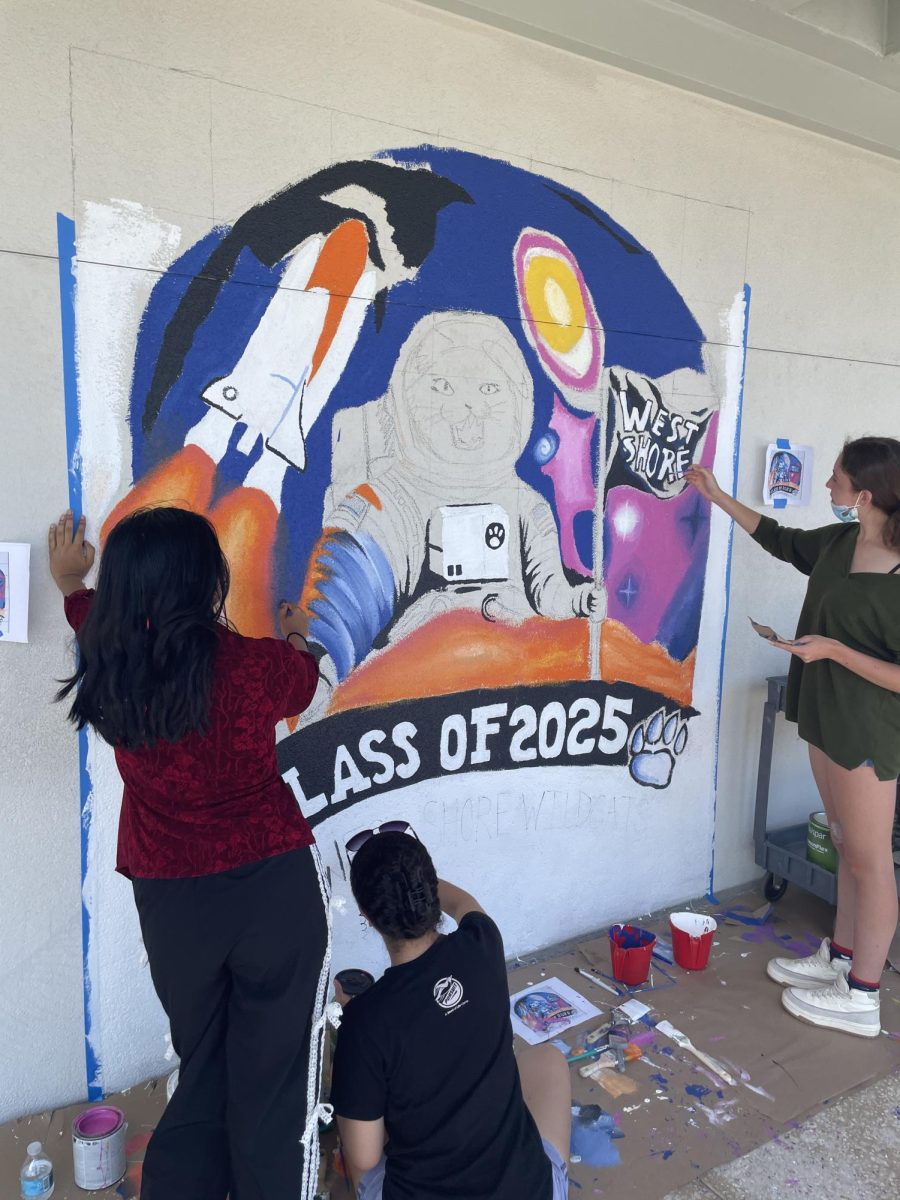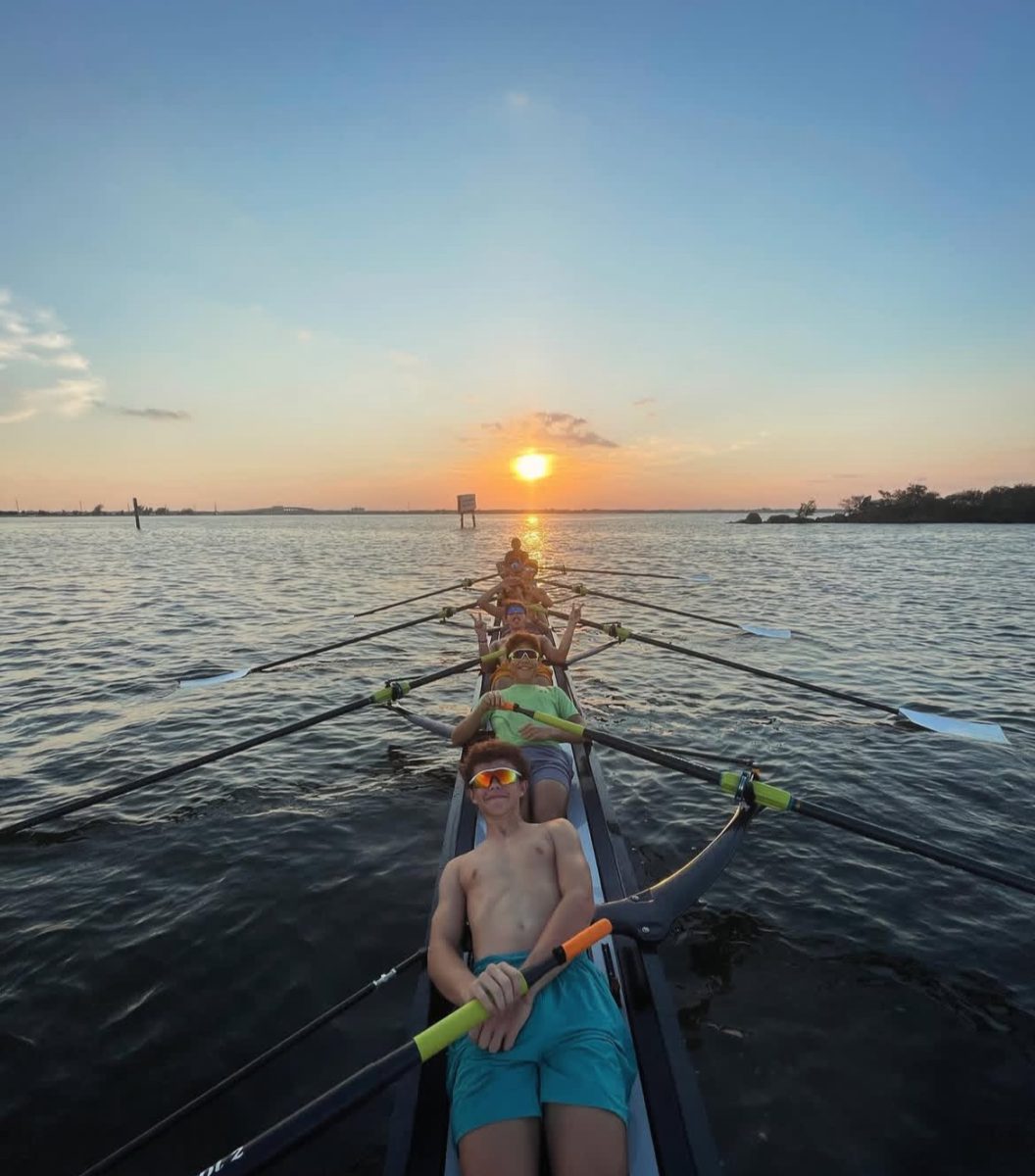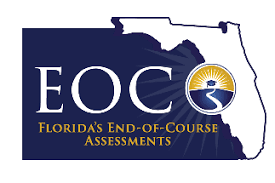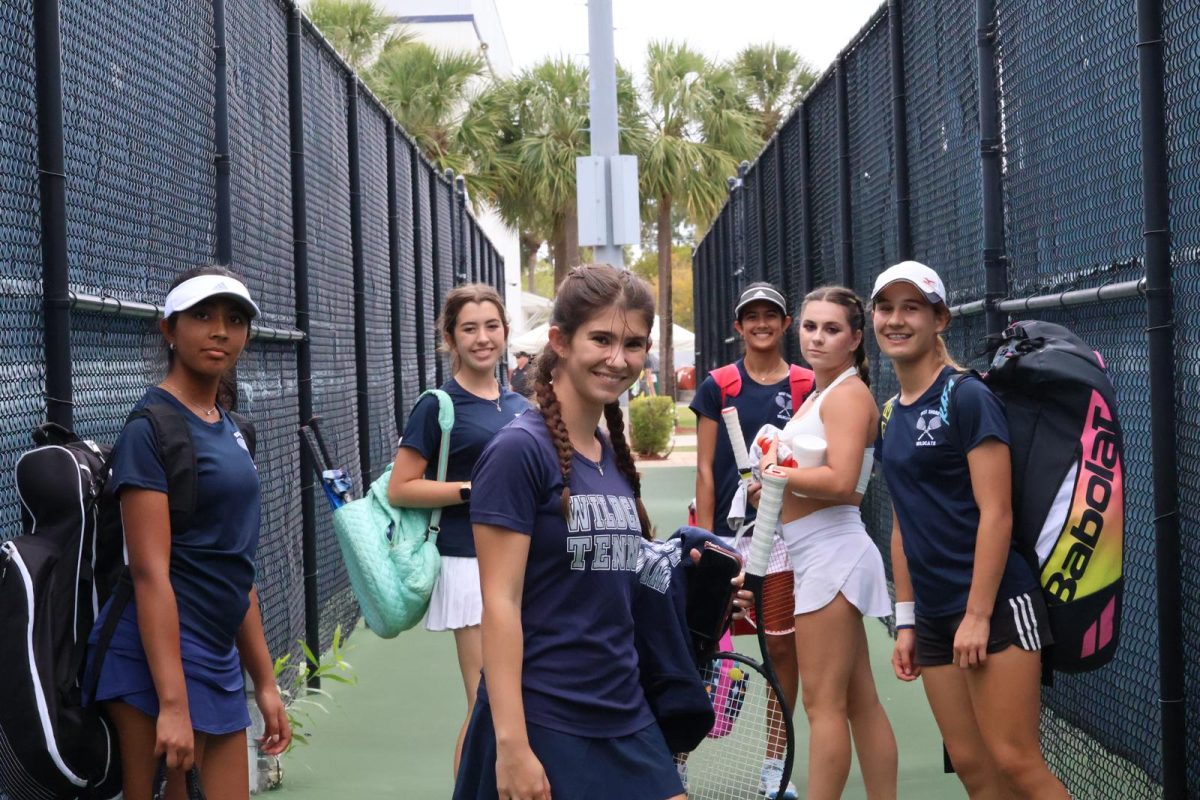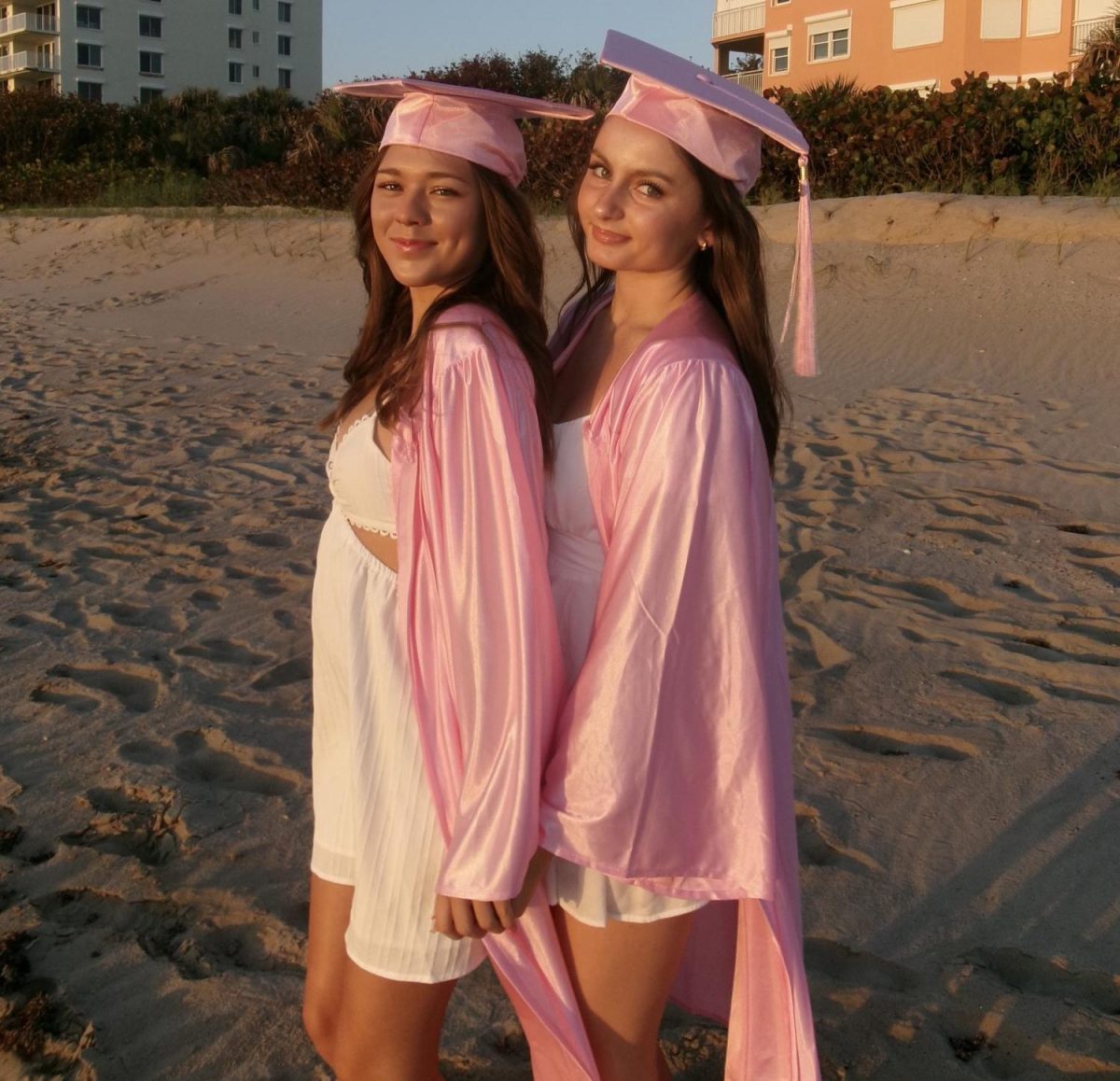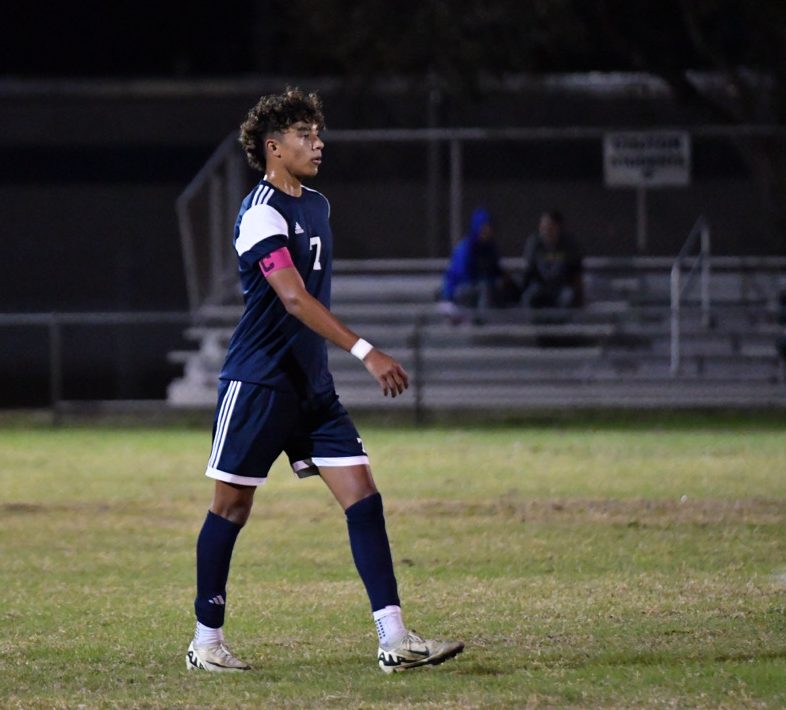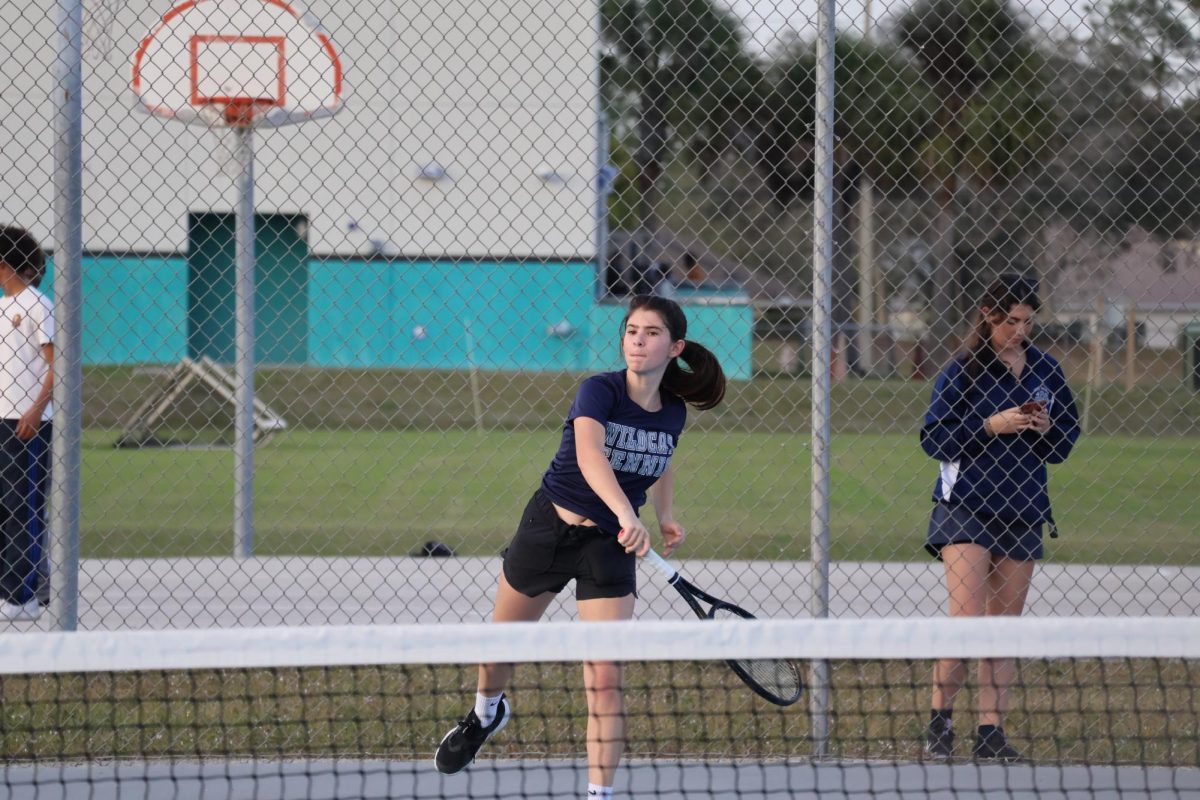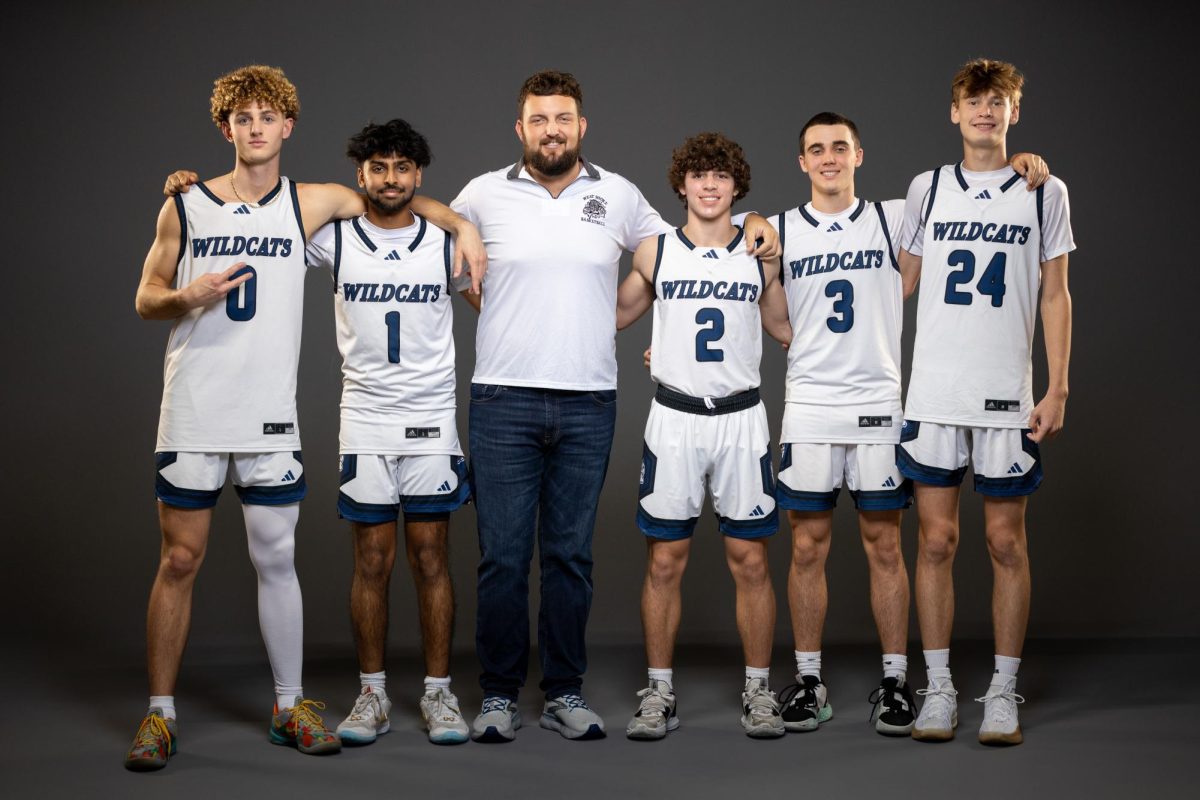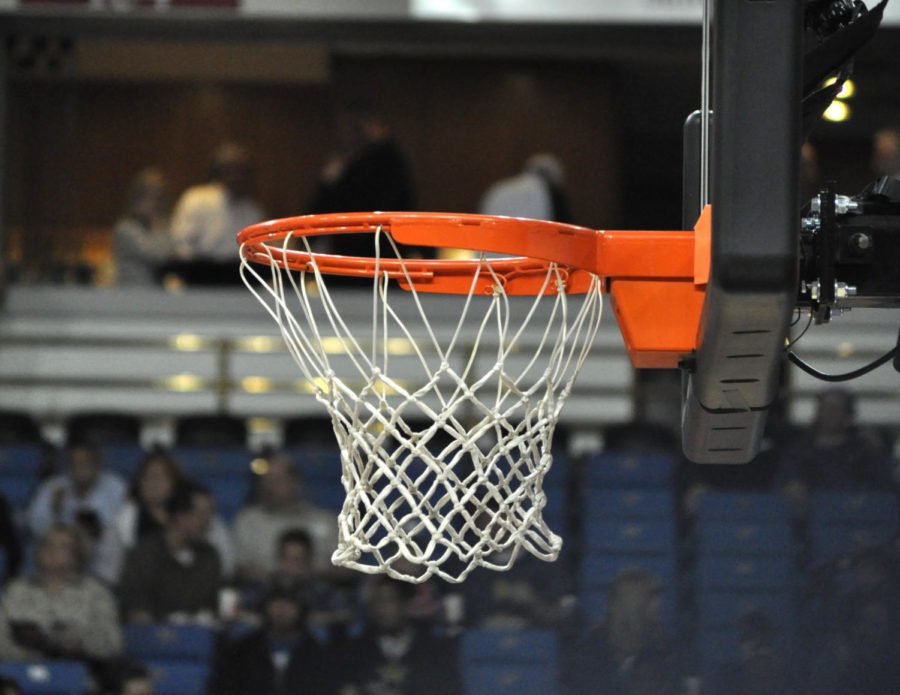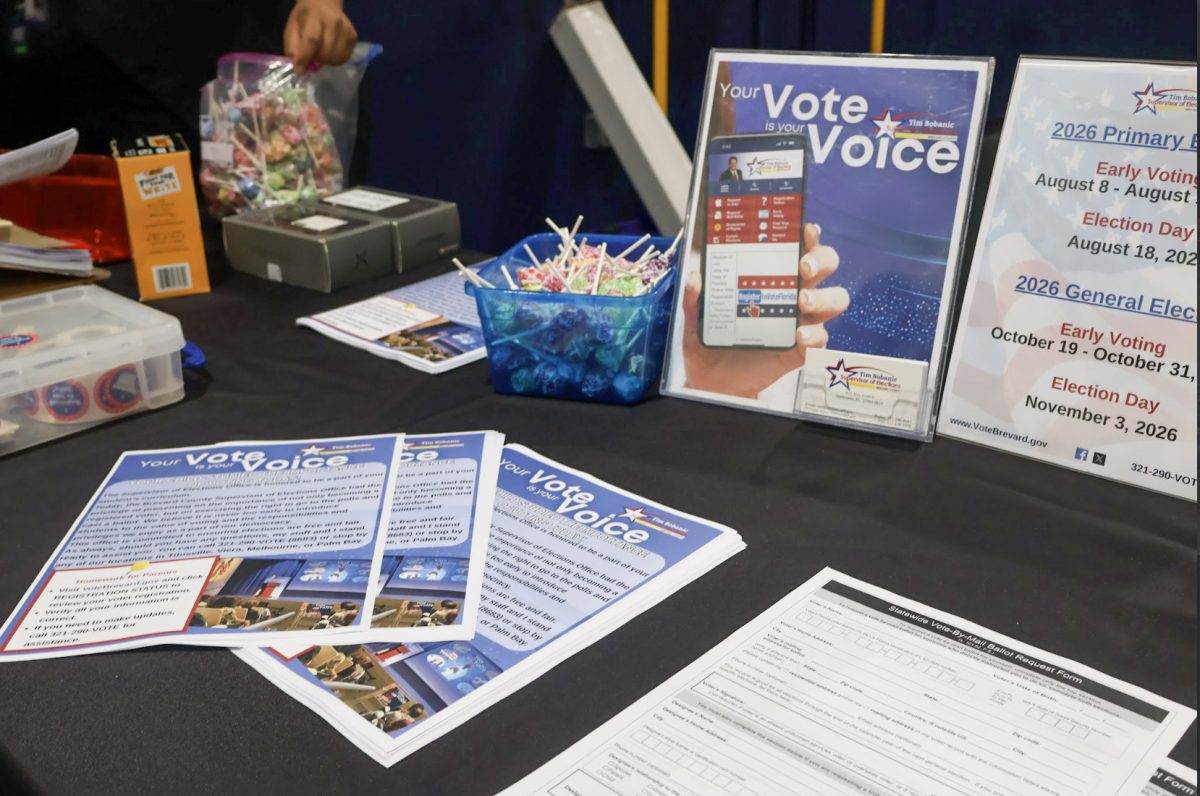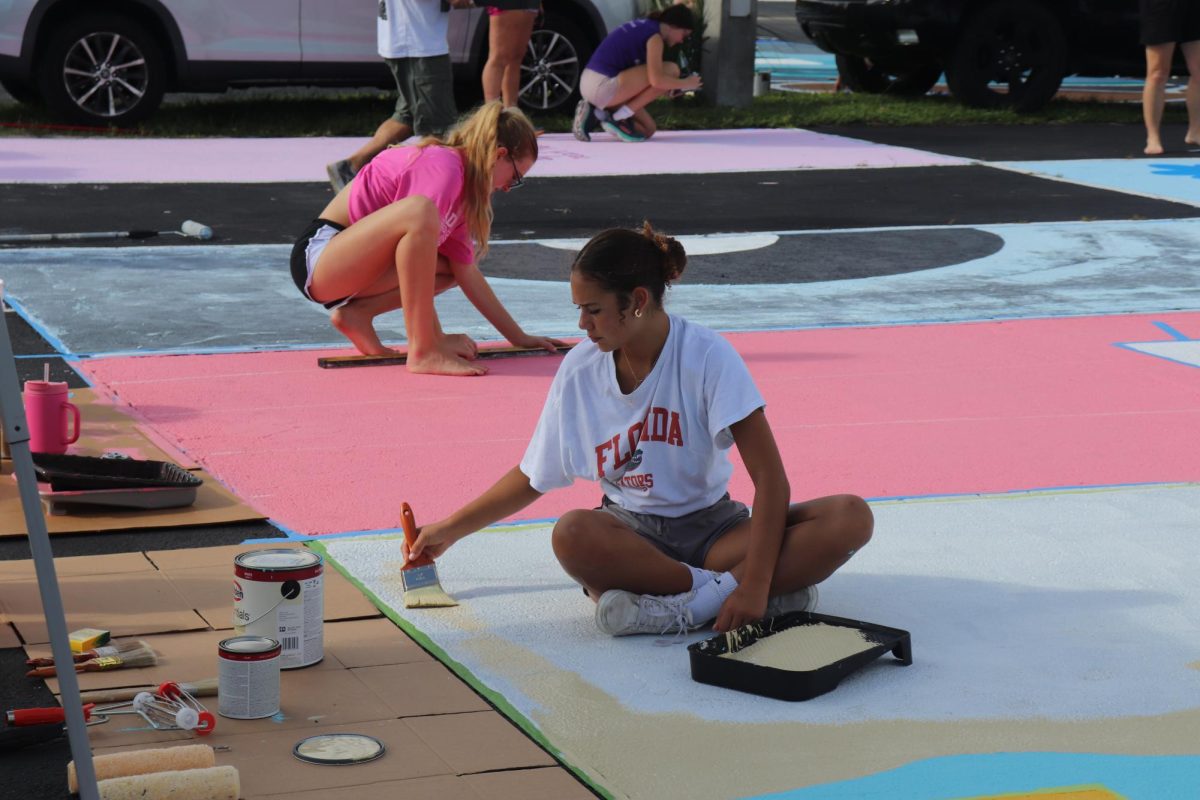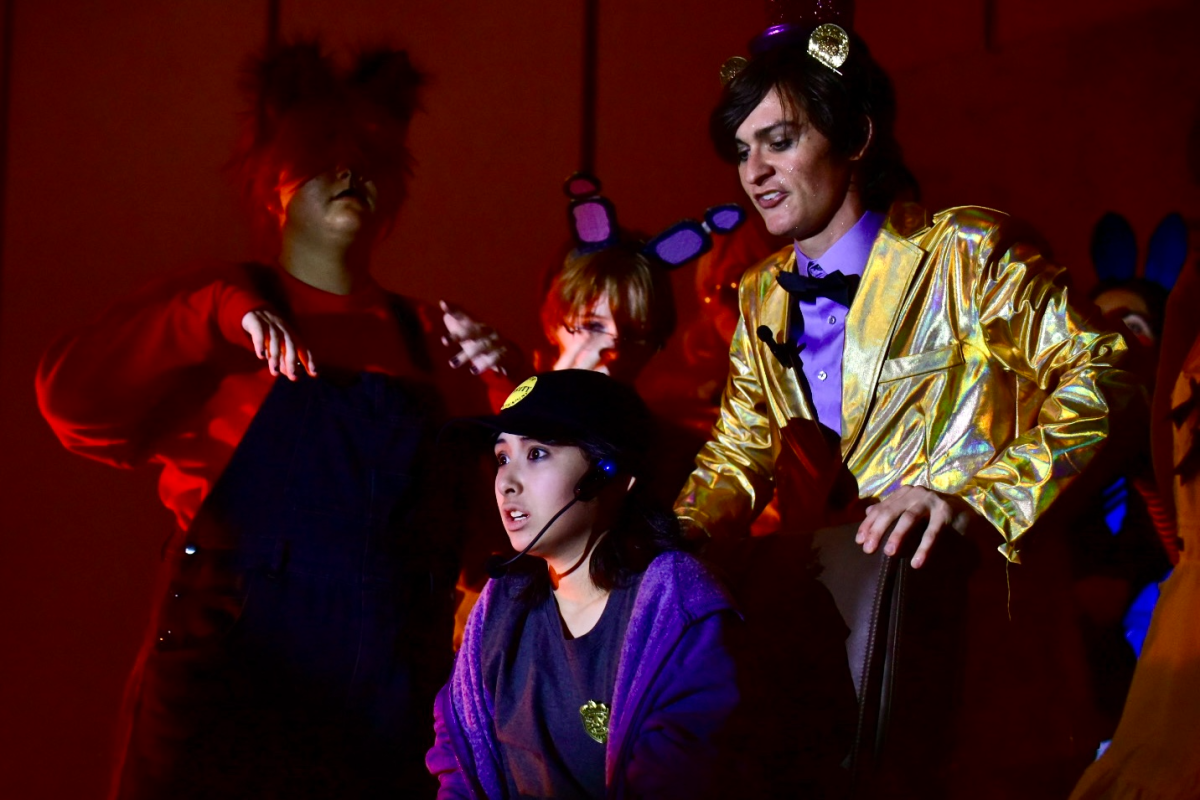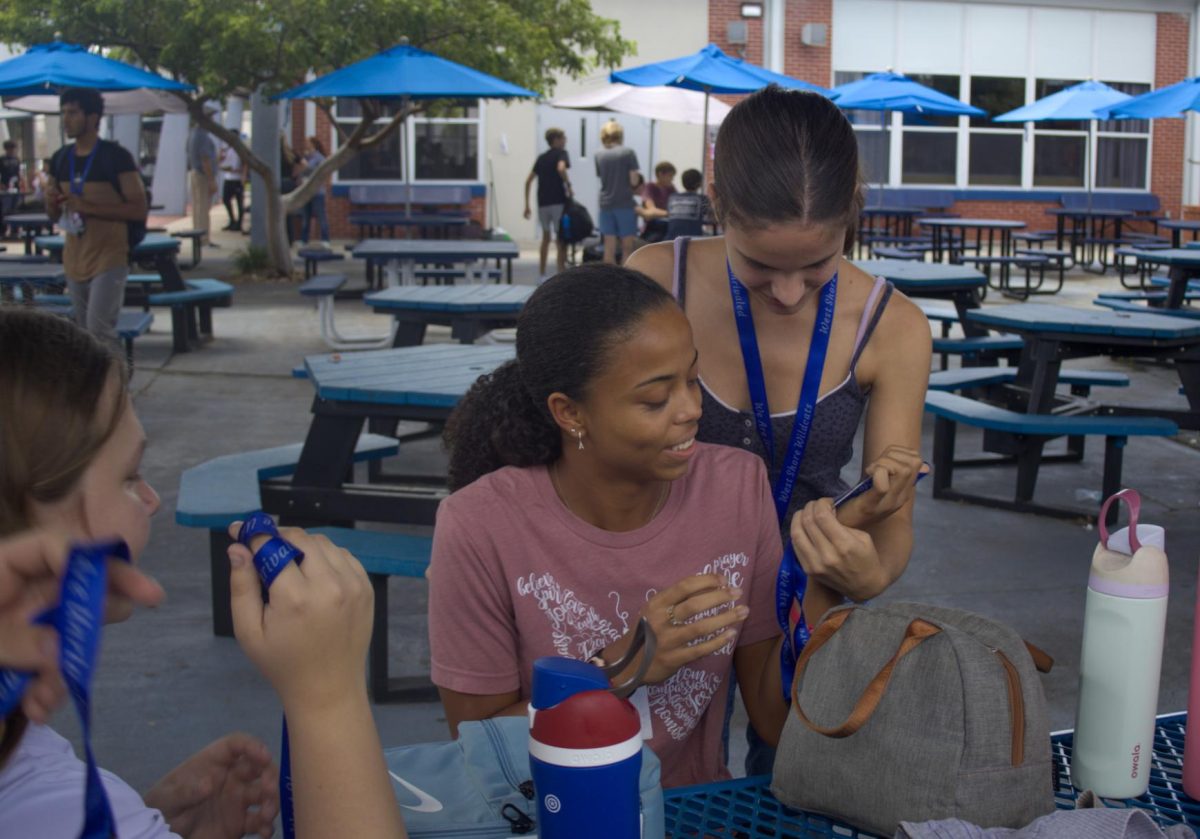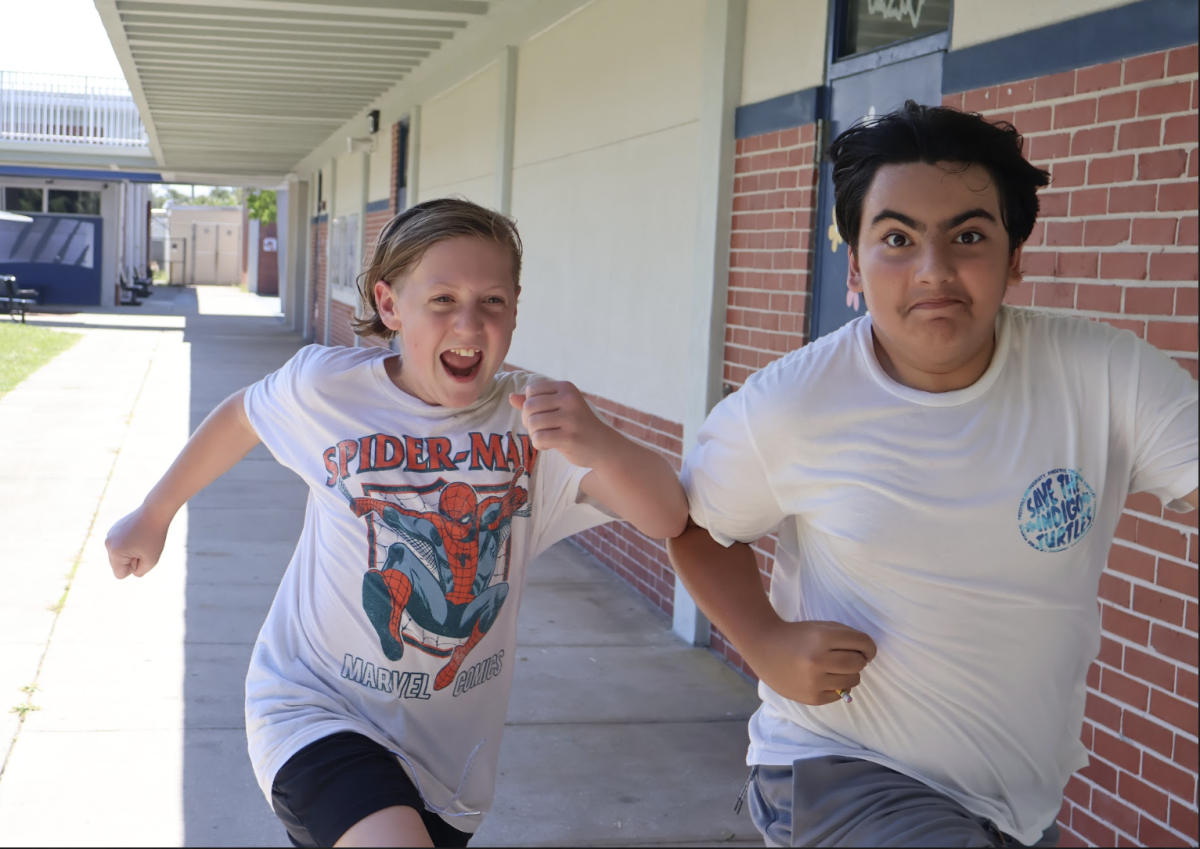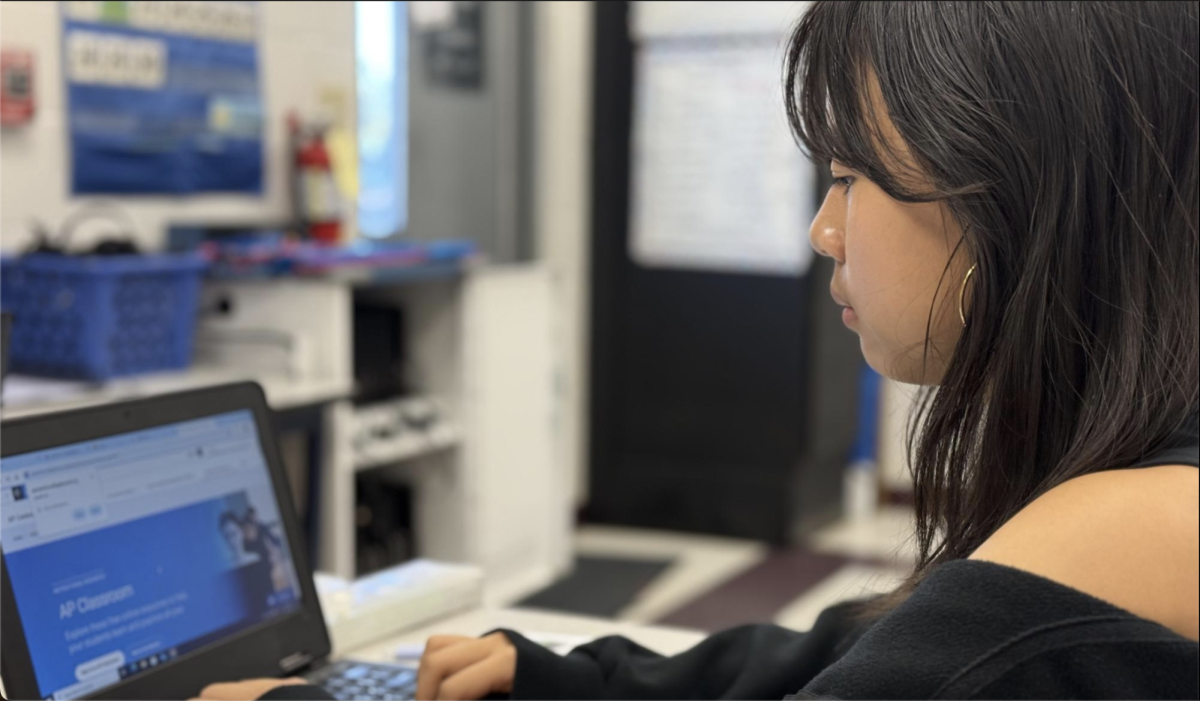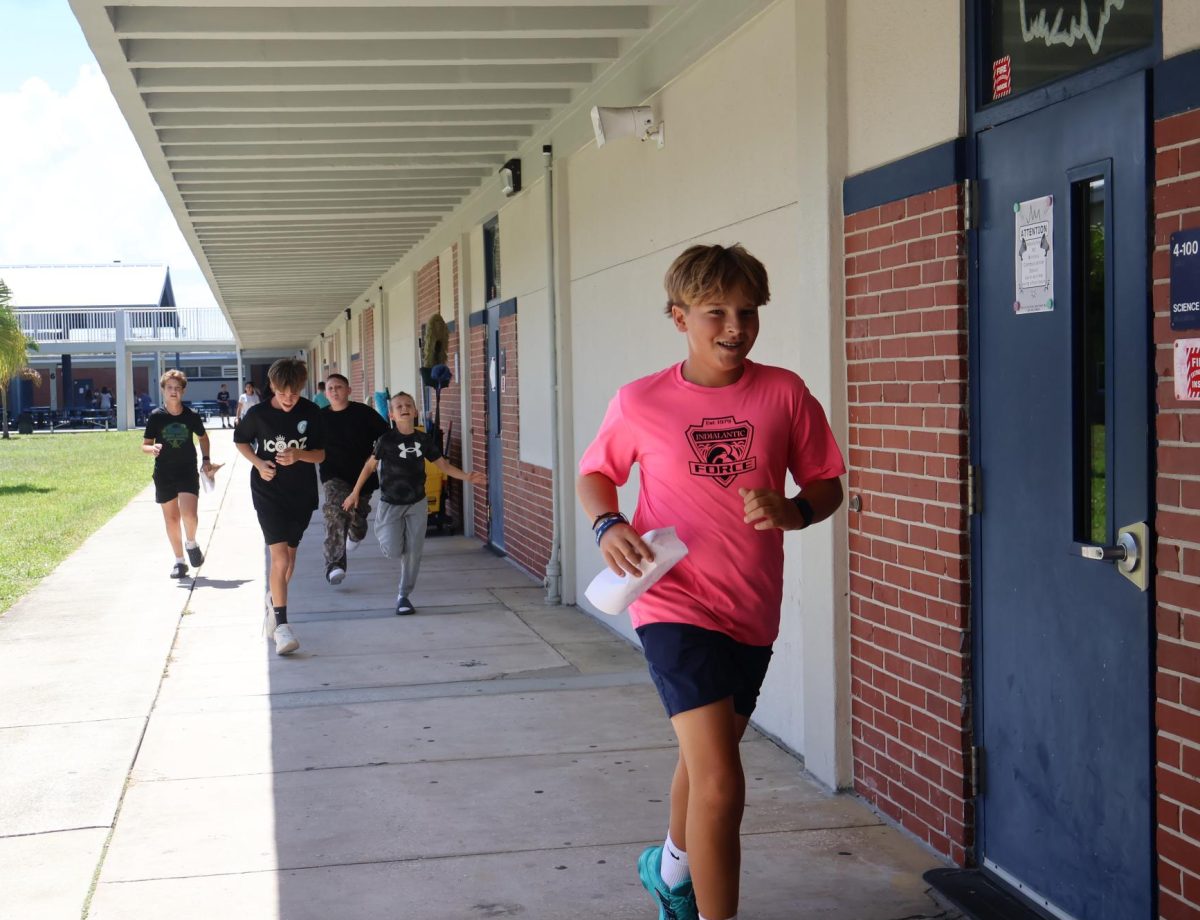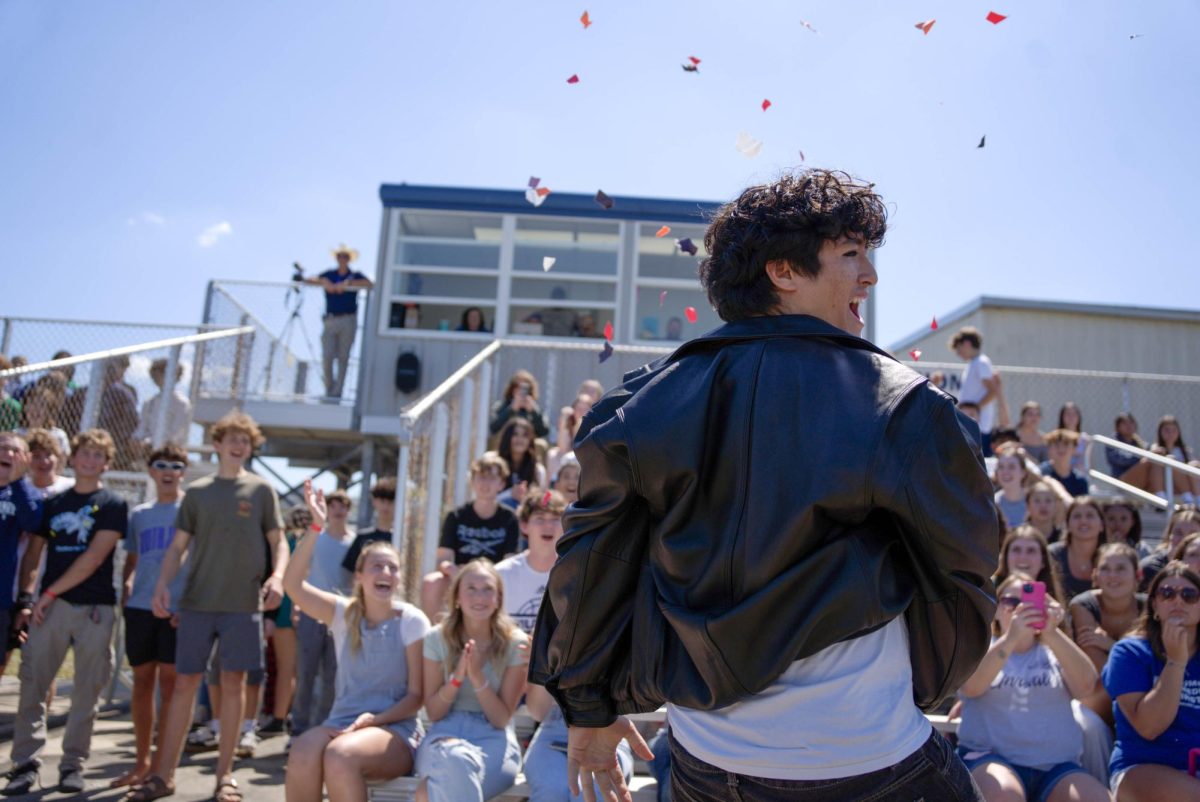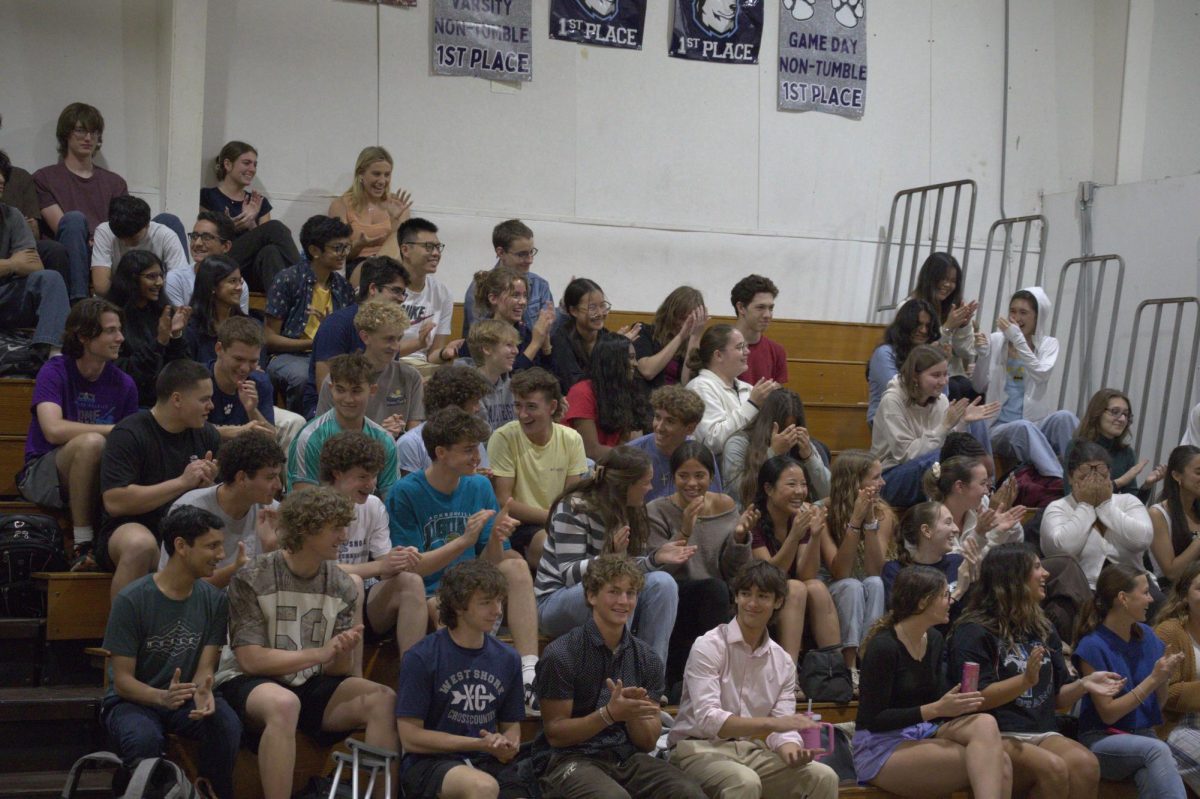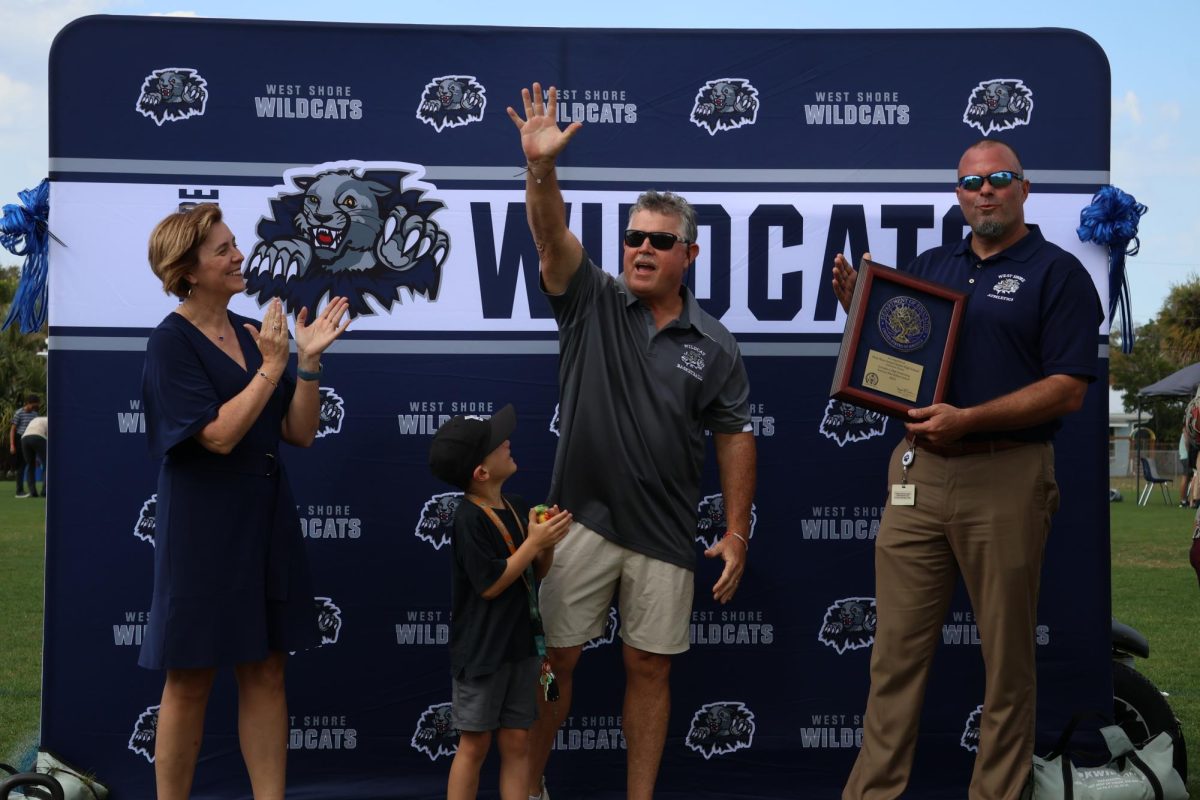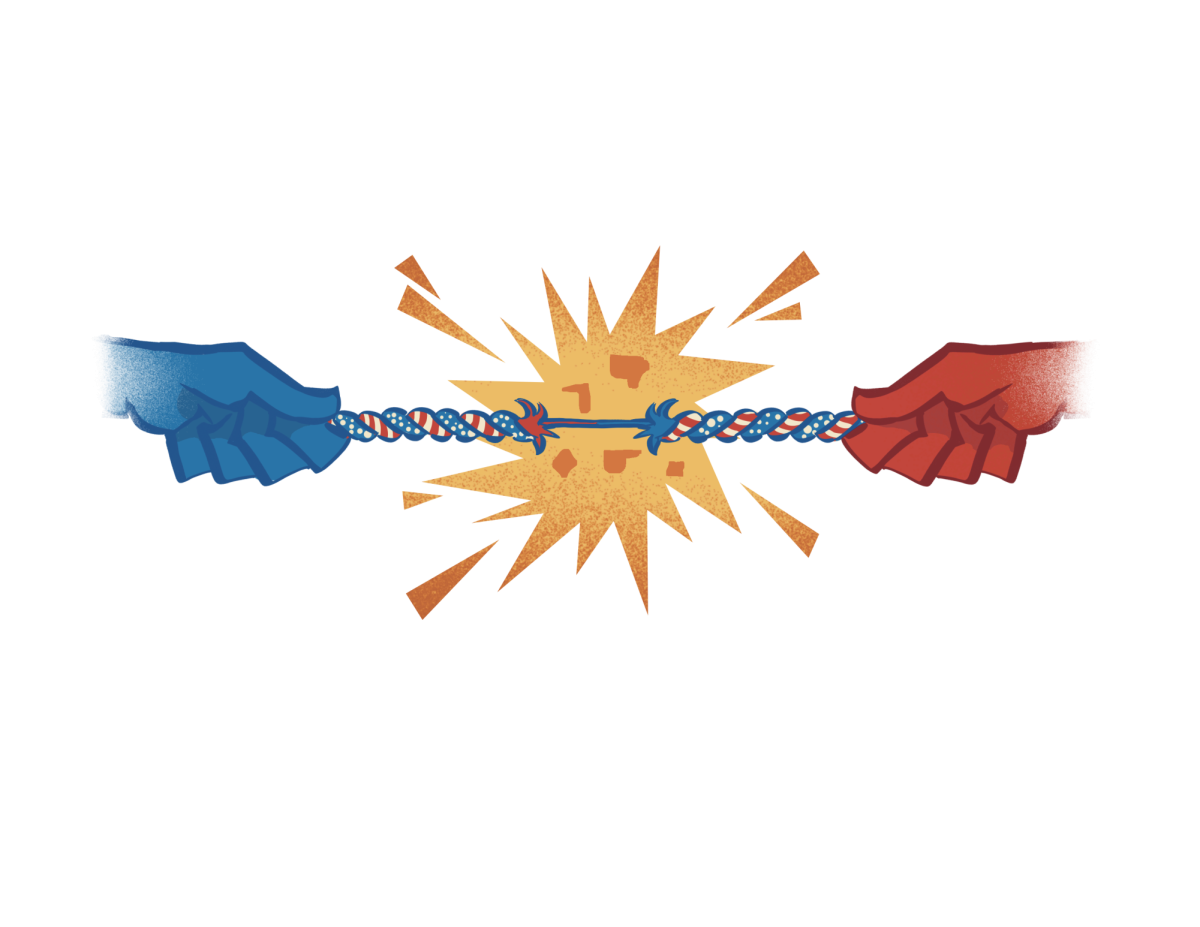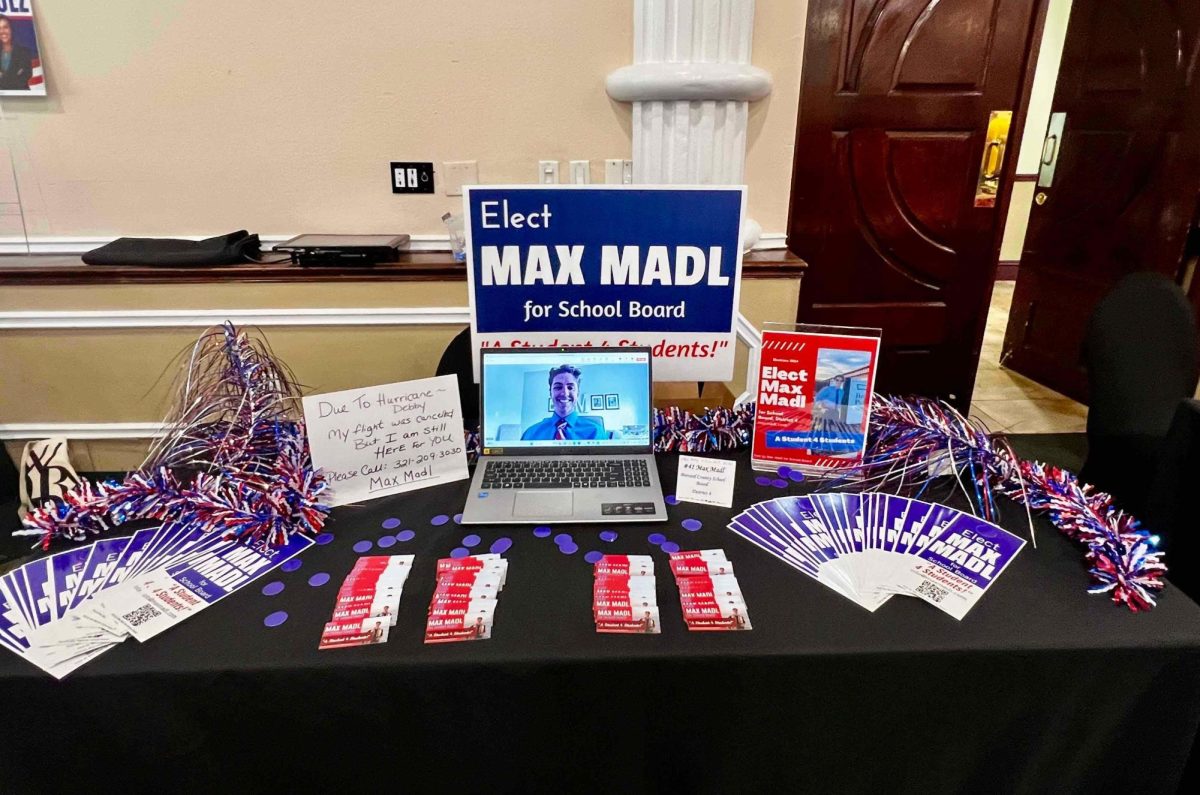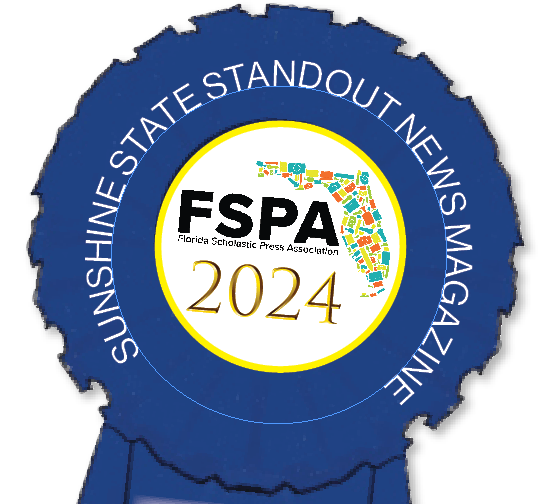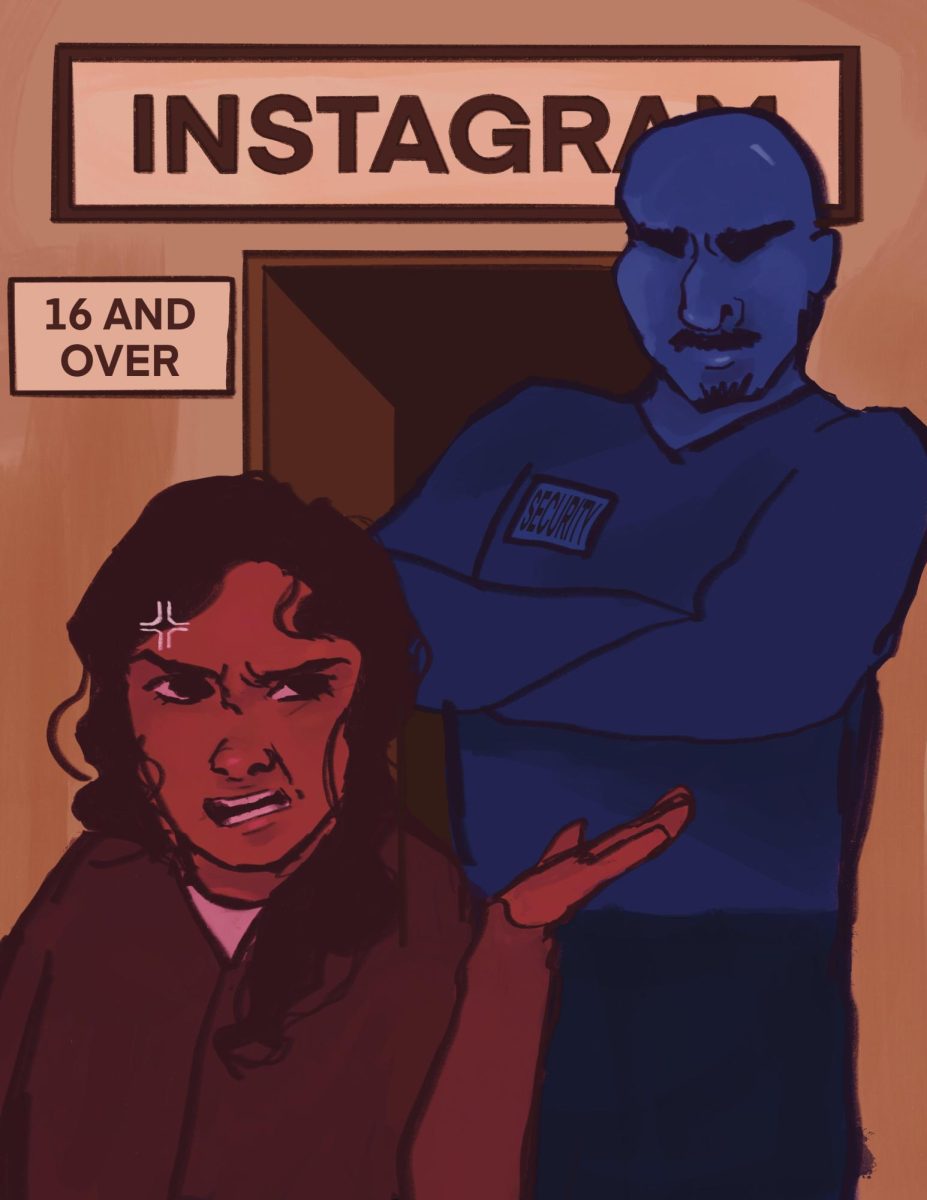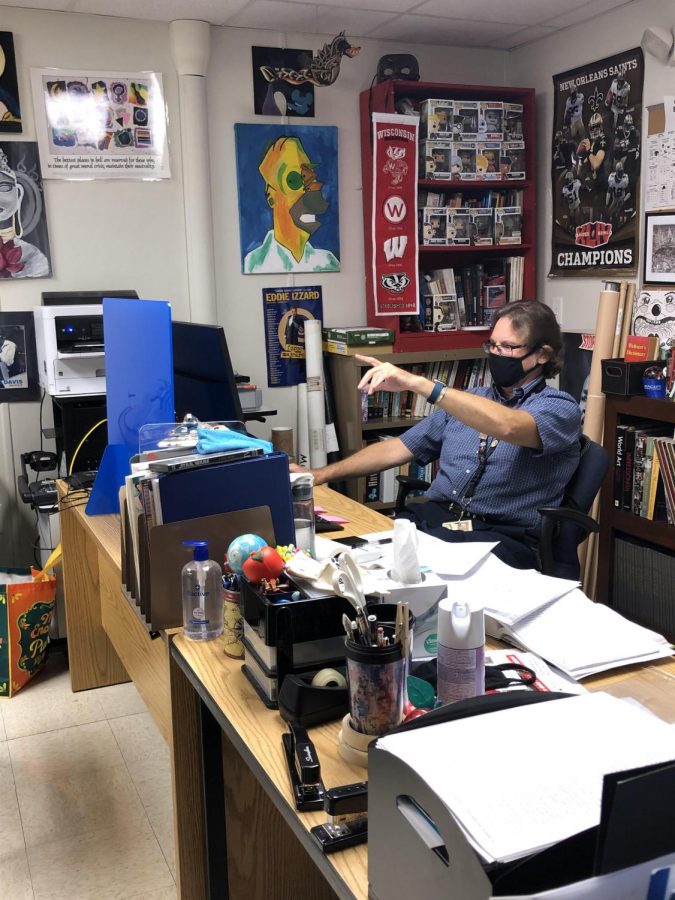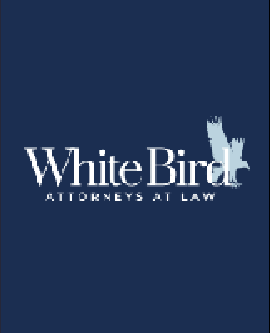Teachers wrestle with health concerns as school reopens during pandemic
History teacher Kirk Murphy instructs humanities from behind his desk barrier.
September 8, 2020
“This is just a room. Without you, it has no class,” English teacher Lisa Rehm posted to her Google Classroom. Then she got to work packing up an empty classroom at the end of the 2019-2020 school year.
“Ms. Rehm, when you look at the room, don’t feel sad,” one of Rehm’s seventh-graders said on the Google Classroom stream. “See all of the hope that is in the room, and now all of that hope is with your students.”
The end of the 2019-2020 school year was surreal for teachers, as they faced the task of teaching remotely, isolated from their students they had previously seen and instructed every day on campus.
“I cried,” Rehm said, in response to her Google Classroom post. “It touched my heart. The whole thing has been very emotional, because it’s impacting everyone.”
When the unprecedented school year ended, while students turned to a summer vacation of rest and relaxation, teachers held their breath in anticipation of what the new school year would hold.
“The difficult thing with this is, no one had any idea what things might look like by the time school was ready to start again,” Rehm said. “So it was really difficult to make plans or anticipate. My hope was we would be in a place where we would be under the 5% and it would be safer to come back to school.”
As summer drew on, and the Brevard County School Board and state government pondered how to grapple with the rising coronavirus cases, teachers such as Rhem waited with bated breath to hear what the upcoming school year would look like.
“I had wondered if at the state level, if they really gave thought to the 20-25% of teachers who are at higher risk,” Rehm said.
On July 6, Education Commissioner Richard Corcoran announced a school reopening mandate. As the Brevard County School Board responded by developing e-learning options for students, teachers were given two choices: teach in-person amid a pandemic, or leave their school community.
“The governor, I heard him say in his news briefings, that they would take care of the most vulnerable,” Rehm said. “And he also said that any teacher who needed to work virtually, from home, would be able to do so. And the reality is not that.”
For Rehm, COVID-19 poses a risk for her crohn’s disease. The autoimmune disease that primarily impacts the digestive system, also influences the stability of other body parts and functions. While Rehm has undergone various surgeries for the disease, she still feels as though “the body is attacking itself.” In response to the reopening mandate, she wrote to the governor, Corocan and the School Board regarding her safety concerns. Over the summer, Rehm “has truly taken the stay at home seriously” and ventured beyond her house for prescriptions, groceries and the occasional trip to the beach. She also visited her parents from the other side of their home’s screen enclosure. With the fluctuating decisions of the state and school board over the summer, Rehm said she wishes there was a better organized and executed timeline for teachers to prepare for school.
“[The governor and Corcoran] put out the order saying that schools had to be open for at least five days a week,” Rehm said. “I always kind of laugh at the ‘five days a week’ because it’s like, ‘Are they going to add Saturday and Sunday too?’”
In response to the reopening mandate, the Florida Education Association filed a lawsuit regarding the constitutionality of the order. The lawsuit is being processed. The FEA “is the united voice for excellence in public education in Florida,” according to communications and PR specialist, Joni Branch.
“We advocate for students, educators, public PreK-12 schools and Florida’s public colleges and universities,” Branch said. “All Florida students should have the opportunity for a high quality education in our public schools. Our state’s constitution mandates that those schools must also be safe.”
The FEA worked alongside teachers over the summer to advocate for educators’ safety. Rehm, too, wrote to the governor, Corcoran and the school board to express concerns about returning to campus.
“Some teachers even wrote wills in advance of being asked to return to in-person learning,” Branch said. “Some teachers with underlying conditions or high-risk family members are concerned that they are not being offered the option of teaching remotely without returning to a campus. In Palm Beach County, school district administrators are facing outrage over the fact that they have not set up a way for at-risk employees to request that they be allowed to teach remotely rather than in person. In areas where virus positivity rates remain high, teachers are concerned about students being subjected to a disruptive open/close cycle as classrooms or whole campuses are exposed to the virus. Cleanliness on campus and insufficient measures to mitigate virus risk, such as a lack of proper equipment and inability to social distance, also are concerns.”
The Brevard County Schools Board’s reopening task force read about 13,000 anonymous Google Form surveys from students, parents, teachers, doctors and other community members. Common concerns varied, according to District Five School Board member, Katye Campbell. After categorizing the thousands of concerns and discussing the topics at multiple eleven-hour school board meetings, masks were deemed “mandatory” and plans were finalized to require block schedules for schools.
“It’s really important to know from the get-go, you can’t really pin down one group from our community and say, ‘All of the fill-in-the-blanks feel this way,’” Campbell said. “So from the beginning with the 13,000 people, all the way to the emails I get in my inbox today, they’re divided. In the same day, within the same hour, [I will] get an email from one teacher saying ‘Masks are crazy, when are we going to get rid of them?’ and from another [teacher] saying, ‘People aren’t wearing their masks like they’re supposed to.’ It’s really hard to say ‘OK, the teachers want this, the students want this, the parents want this,’ because they’re so divided.”
Despite varying opinions regarding the safety measures taken, Campbell said the transition to a block schedule cuts teachers’ exposure to students in half. Instead of teaching seven classes a day for 49 minutes each, teachers would have four classes a day for 90 minutes each. All students would have four classes for the first half of the school year, then transition to four new classes for the second half of the school year.
“We do know that it’s important to keep our staff safe,” Campbell said. “That’s one of the reasons why we upped the language on masks to ‘expected.’ Everyone needs to be wearing a mask when you’re not able to social distance.”
Campbell also said that “it’s so important to meet the needs of students” and that ultimately, some students needed schools to be open for a place to learn and grow. However, others believe that no matter how cautious schools are, the risk of returning to campuses is too great.
“In many ways I see the forced opening of schools as some type of a political tool or ploy,” history teacher Kirk Murphy said. “I am not happy to be a tool of any ideology. Ignoring science is not the thing to do in the midst of a pandemic.”
Murphy expected for the distance learning that teachers and students experienced in the spring would be expanded upon this school year. He said he was “upset, concerned and disgusted” to find that schools would reopen, with teachers on the frontline.
“This darn thing is insidious,” Murphy said. “[COVID-19] hits people in different ways. I have no desire to be on a respirator or put into a coma for days or weeks. I am worried that the financial burden from getting COVID-19 would ruin my family.”
Murphy, as an only child, is the primary caretaker for his parents, who both fall into the high-risk category for COVID-19.
“My father ticks every box for high risk and my mother ticks most of them,” Murphy said. “I am terrified more about passing this on to someone I care about. Now that school has started I have cut myself off from my wife and parents. I am living in the guest room and staying away from everyone. I talk with people on the phone or through text and talk with my wife through the sliding glass door.”
For Murphy, the mask mandate from the school board and the sanitation supplies distributed to teachers does not compare to the safety of remote instruction.
“Yes, requiring masks is good,” Murphy said. “But there is no way in most classrooms to social distance. Fortunately, most of our hallways are outside so we will not have problems like we’ve seen in other schools.”
For teachers like Murphy, the image of a packed high school hallway in Georgia that went viral in previous weeks, is ingrained in their brain.
“There is no good way to stop this, short of not having students at the school,” Murphy said. “While it is nice to be teaching again and see the students, it’s hard. Teaching in person and [for] e-learners at the same time takes some getting used to. Throw into all that block scheduling and it feels like we are spinning our wheels sometimes.”
Further controversy arose as other high-risk teachers faced the decision to return to campuses. This was the case for middle school math and robotics teacher, Jill Whitacre. Whitacre lost one-third of her lung to cancer. Despite a susceptible immune system, Whitacre said she would not have left her school community.
“There was never any question about [returning],” Whitacre said. “There’s nothing else I would ever want to do. When we left [in March] – that whole period we were dealing with remote learning – that was very hard for me. I was really depressed. I didn’t realize how much I loved [teaching]. I didn’t realize how much the kids meant to me, until I was home. At the same time I have my health issues and my age. I am a vulnerable person, but I knew I was going to come back. My son was very worried about it. My daughter was very worried about it.”
With COVID-19 impacting the respiratory system in particular, Whitacre has taken every precaution possible to teach safely. Whitacre encourages the use of personal wireless mice for students using chromebooks, and has a UV wand to sanitize computers and an air purifier for the classroom. One student’s parents also proposed the idea to attach individual hand sanitizer pumps to a leg of each desk. Whitacre said her mission is to keep her students healthy, so that in return, they will keep her healthy.
“We have very respectful students,” Whitacre said. “I want to be here with [them], but the only way I can be here with [them] is if [they] wear a mask. And I don’t think I’ll ever have a student who will challenge that. They understand that and care about us as students. I think it’s hard to say ‘OK, we’ve got to do this for the good of humanity.’ If I know [the person] I’ve got to take care of, then I’ll be like, ‘Oh, I’ll do whatever you need me to do.’”
A primary concern for Whitacre is the case of maskless students eating lunch together. Sitting together in close proximity while they eat, talk and laugh provides normalcy to students, but with possible risk of exposure.
“The worry for me was that as schools started, Florida [would] start getting more cases,” Whitacre said. “At first, I wasn’t as concerned until I saw Florida kind of going on fire. I watched the school board meetings very closely. My hope was that we could come back, but everyone would wear a mask and there would be social distancing. We would not have so many kids in class. That’s what I was hoping.”
But the vision of smaller class sizes was far from reality, particularly for Rehm. While Rehm said she anticipated class sizes of about ten students, two of her classes have 16 and 17 students in-person.
“I’m coming from a place where all summer I was in a very controlled environment,” Rehm said. “And now I’m in an environment where I have a lot less control. And not by anyone’s fault, it’s just how school is. I think that our school administration and our custodians are truly doing everything that they can. There’s so much that we don’t know about [COVID-19] and what the long-lasting effects are. When I hear about cases, I always wonder, ‘Are they taking the same precautions that we’re taking?’”
Only time will tell the effectiveness of safety precautions teachers have taken against COVID-19. But for now, Rehm, Murphy and Whitacre will continue their teaching careers – in class – from six feet.
“As teachers, we’re used to things pivoting,” Rehm said. “Things change and we just have to go with the flow, and make sure we’re doing it in the best interest of our students. I feel like everything we can do is being done. I still feel myself going toward the students, and that’s really difficult. Now that I’m here I feel more comfortable. But I don’t want to get to the point where I feel too comfortable, that I let my guard down.”

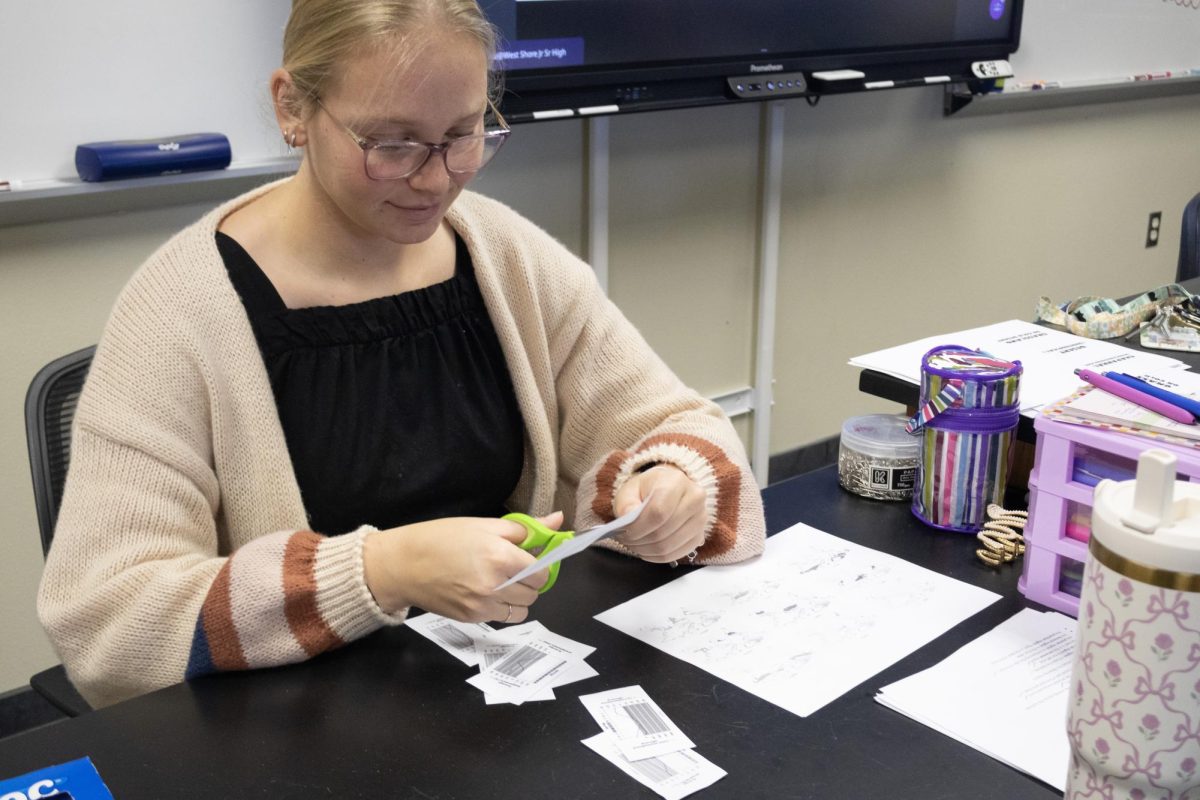
![Sophomore Isabelle Gaudry walks through the metal detector, monitored by School Resource Officer Valerie Butler, on Aug. 13. “I think [the students have] been adjusting really well," Butler said. "We've had no issues, no snafus. Everything's been running smoothly, and we've been getting kids to class on time.”](https://westshoreroar.com/wp-content/uploads/2025/08/IMG_9979-1200x800.jpg)
